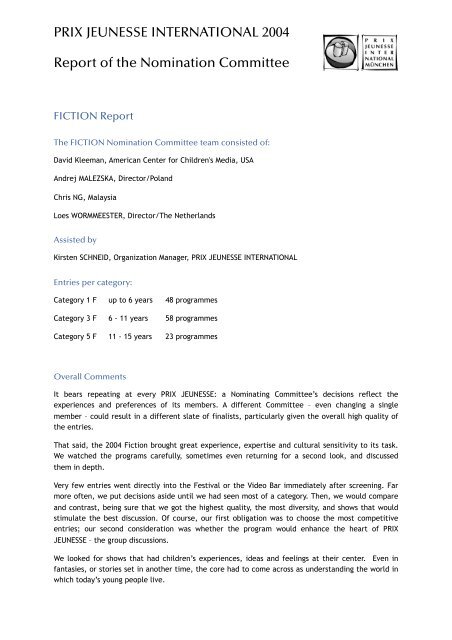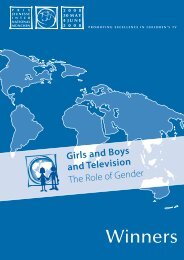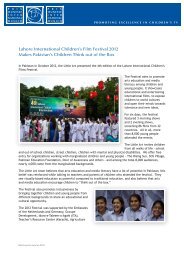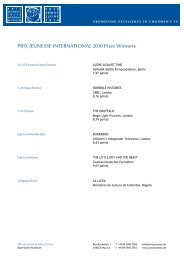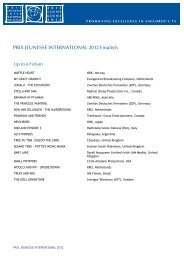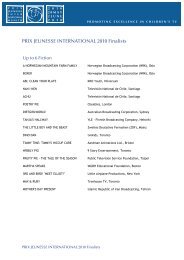PRIX JEUNESSE INTERNATIONAL 2004 Report of the Nomination ...
PRIX JEUNESSE INTERNATIONAL 2004 Report of the Nomination ...
PRIX JEUNESSE INTERNATIONAL 2004 Report of the Nomination ...
Create successful ePaper yourself
Turn your PDF publications into a flip-book with our unique Google optimized e-Paper software.
<strong>PRIX</strong> <strong>JEUNESSE</strong> <strong>INTERNATIONAL</strong> <strong>2004</strong><br />
<strong>Report</strong> <strong>of</strong> <strong>the</strong> <strong>Nomination</strong> Committee<br />
FICTION <strong>Report</strong><br />
The FICTION <strong>Nomination</strong> Committee team consisted <strong>of</strong>:<br />
David Kleeman, American Center for Children's Media, USA<br />
Andrej MALEZSKA, Director/Poland<br />
Chris NG, Malaysia<br />
Loes WORMMEESTER, Director/The Ne<strong>the</strong>rlands<br />
Assisted by<br />
Kirsten SCHNEID, Organization Manager, <strong>PRIX</strong> <strong>JEUNESSE</strong> <strong>INTERNATIONAL</strong><br />
Entries per category:<br />
Category 1 F up to 6 years 48 programmes<br />
Category 3 F 6 - 11 years 58 programmes<br />
Category 5 F 11 - 15 years 23 programmes<br />
Overall Comments<br />
It bears repeating at every <strong>PRIX</strong> <strong>JEUNESSE</strong>: a Nominating Committee’s decisions reflect <strong>the</strong><br />
experiences and preferences <strong>of</strong> its members. A different Committee – even changing a single<br />
member – could result in a different slate <strong>of</strong> finalists, particularly given <strong>the</strong> overall high quality <strong>of</strong><br />
<strong>the</strong> entries.<br />
That said, <strong>the</strong> <strong>2004</strong> Fiction brought great experience, expertise and cultural sensitivity to its task.<br />
We watched <strong>the</strong> programs carefully, sometimes even returning for a second look, and discussed<br />
<strong>the</strong>m in depth.<br />
Very few entries went directly into <strong>the</strong> Festival or <strong>the</strong> Video Bar immediately after screening. Far<br />
more <strong>of</strong>ten, we put decisions aside until we had seen most <strong>of</strong> a category. Then, we would compare<br />
and contrast, being sure that we got <strong>the</strong> highest quality, <strong>the</strong> most diversity, and shows that would<br />
stimulate <strong>the</strong> best discussion. Of course, our first obligation was to choose <strong>the</strong> most competitive<br />
entries; our second consideration was whe<strong>the</strong>r <strong>the</strong> program would enhance <strong>the</strong> heart <strong>of</strong> <strong>PRIX</strong><br />
<strong>JEUNESSE</strong> – <strong>the</strong> group discussions.<br />
We looked for shows that had children’s experiences, ideas and feelings at <strong>the</strong>ir center. Even in<br />
fantasies, or stories set in ano<strong>the</strong>r time, <strong>the</strong> core had to come across as understanding <strong>the</strong> world in<br />
which today’s young people live.
<strong>PRIX</strong> <strong>JEUNESSE</strong> <strong>INTERNATIONAL</strong> <strong>2004</strong><br />
<strong>Report</strong> <strong>of</strong> <strong>the</strong> <strong>Nomination</strong> Committee<br />
We did not favor <strong>the</strong> new or innovative over classic stories well told: in both cases, something more<br />
needed to attract us. Was <strong>the</strong> innovation soundly based or simply for <strong>the</strong> sake <strong>of</strong> being different?<br />
Was a classic style well chosen and well executed?<br />
Up to 6 (1 F)<br />
In <strong>the</strong> Up to 6 category (1F), <strong>the</strong> Committee found that it was difficult to sustain a single story for a<br />
full half hour. A number <strong>of</strong> producers solve this by combining two or more shorter stories in a single<br />
program. This made judging difficult in some cases: with limited time in <strong>the</strong> final competition, it’s<br />
hard to ask participants to watch two similar stories that were combined mainly because <strong>the</strong> TV<br />
schedule mandated a half-hour.<br />
<strong>PRIX</strong> <strong>JEUNESSE</strong> should address this in its rules. While programs are supposed to be entered as aired,<br />
for evaluation and discussion, it’s sufficient (and probably preferable) to consider a single story.<br />
The pre-school fiction category <strong>of</strong>fered good variety <strong>of</strong> style and format. It was substantially<br />
balanced among live action and animation, plus a few puppet programs. Even within those<br />
categories <strong>the</strong>re were diverse styles.<br />
The category also <strong>of</strong>fered innovative ideas in content development or presentation, to go along with<br />
some very traditional and well-told stories.<br />
6 – 11 category (3F)<br />
The 6 – 11 category (3F) – as usual – had <strong>the</strong> largest number <strong>of</strong> entries, and a very high standard <strong>of</strong><br />
quality. The Committee agonized over its package <strong>of</strong> finalists, knowing that very good programs<br />
couldn’t be included.<br />
For 3F, it’s particularly important to note that a <strong>PRIX</strong> <strong>JEUNESSE</strong> program need not be aimed at <strong>the</strong><br />
entire category age span. Often, a program will have half its target audience in an adjacent<br />
category, or be targeted only to <strong>the</strong> very bottom or top <strong>of</strong> an age group. Therefore, <strong>the</strong> Committee<br />
debated whe<strong>the</strong>r certain programs were in <strong>the</strong> right category, but did not recommend a change if<br />
<strong>the</strong> producers had completed <strong>the</strong> “specific target audience” box on <strong>the</strong> entry form, and it included<br />
at least some years inside <strong>the</strong> category.<br />
The result is that 3F will be a particularly hard category to judge and discuss. The stories span from<br />
innocent tales for young children, through mainstream animated entertainment, to darker stories<br />
touching on complex societal issues. Much depended on <strong>the</strong> cultures from which <strong>the</strong> programs<br />
came, and <strong>the</strong>ir view <strong>of</strong> childhood.<br />
In this middle age group, <strong>the</strong> Nominating Committee noted two gaps that are interesting as <strong>the</strong>y are<br />
near opposites <strong>of</strong> one ano<strong>the</strong>r. Only a few stories opened windows on typical children’s everyday<br />
lives; but even fewer portrayed fantasy worlds.<br />
12 – 15 category (5F)
<strong>PRIX</strong> <strong>JEUNESSE</strong> <strong>INTERNATIONAL</strong> <strong>2004</strong><br />
<strong>Report</strong> <strong>of</strong> <strong>the</strong> <strong>Nomination</strong> Committee<br />
The 12 – 15 category (5F) was revealing about different countries’ views <strong>of</strong> adolescence. The young<br />
people at <strong>the</strong> center <strong>of</strong> <strong>the</strong> stories ranged from barely teenaged to mid-20s. The issues in <strong>the</strong>ir<br />
lives, not surprisingly, were equally broad. The Committee marveled at <strong>the</strong> risqué <strong>the</strong>mes <strong>of</strong> some<br />
programs, while thinking o<strong>the</strong>rs would be seen as too juvenile for this age group.<br />
Love and friendship were consistent topics, though, and <strong>the</strong> finalists will include an excellent crosssection<br />
<strong>of</strong> stories from different cultures about teen relationships, that should result in great<br />
discussions.<br />
5F programs that made it to <strong>the</strong> final round tended to be au<strong>the</strong>ntic in <strong>the</strong>ir dialogue, settings and<br />
emotions. Teens quickly reject stories <strong>the</strong>y sense to be lecturing or condescending, or that feel as if<br />
adults are trying to tell <strong>the</strong>m what to find “cool.”<br />
David Kleeman<br />
April <strong>2004</strong><br />
NON-FICTION <strong>Report</strong><br />
The NON-FICTION <strong>Nomination</strong> Committee team consisted <strong>of</strong>:<br />
Kalle FÜRST, NRK/Norway<br />
Dr Irene WELLERSHOFF, ZDF/Germany<br />
Firas DEHNI, STV/Syria<br />
Marion CREELY, RTE/Ireland<br />
Assisted by<br />
Ursula von ZALLINGER, Secretary General, <strong>PRIX</strong> <strong>JEUNESSE</strong> INTL<br />
Entries per category:<br />
Category 2 NF up to 6 years<br />
Category 4 NF 6 - 11 years<br />
Category 6 NF 11 - 15 years<br />
19 programmes<br />
70 programmes<br />
40 programmes<br />
Overall Comments<br />
<strong>PRIX</strong> <strong>JEUNESSE</strong> <strong>2004</strong> will be a showcase for children’s broadcasting worldwide. With more than<br />
entries from North and South America, Asia, Africa, Australia, <strong>the</strong> Middle East and Europe, <strong>the</strong><br />
festival <strong>of</strong>fers an unrivalled opportunity to learn about global trends in children’s broadcasting. The
<strong>PRIX</strong> <strong>JEUNESSE</strong> <strong>INTERNATIONAL</strong> <strong>2004</strong><br />
<strong>Report</strong> <strong>of</strong> <strong>the</strong> <strong>Nomination</strong> Committee<br />
Festival will this year include 89 finalists in <strong>the</strong> three non-fiction categories from 120 broadcasters<br />
and 69 countries. These include magazines, food shows, science and art shows, reality TV shows,<br />
news bulletins and news features, observational documentary series and traditional documentaries.<br />
The over-all calibre <strong>of</strong> <strong>the</strong> entries was very high, resulting in long and agonising discussions among<br />
<strong>the</strong>, toward <strong>the</strong> unenviable but inevitable task <strong>of</strong> excluding some fine productions from <strong>the</strong> Festival<br />
for reasons <strong>of</strong> time.<br />
The Pre-Selection Comittee looked for programmes that are for <strong>the</strong> child and not simply about <strong>the</strong><br />
child. We looked for originality and imagination in <strong>the</strong> use <strong>of</strong> <strong>the</strong> language <strong>of</strong> television, appropriate<br />
choice <strong>of</strong> presenter, clarity <strong>of</strong> communication, and a good understanding <strong>of</strong> <strong>the</strong> child’s world and<br />
how best to communicate with it. While production standards were always a priority, <strong>the</strong> Pre-<br />
Selection Committee also gave importance to representing diversity <strong>of</strong> geography and format in <strong>the</strong><br />
final selection.<br />
There are exciting trends. Broadcasters seem more confident to place children at <strong>the</strong> centre <strong>of</strong><br />
programmes as star or commentator. This represents growing trust in young people’s perspective<br />
and judgement. There is an attempt to be innovative around information, using formats also<br />
gaining fashion in adult TV, such as ’reality TV.’<br />
In documentary, broadcasters are investing in longer production periods to bring added truth and<br />
diversity. Food programmes seem to be universally popular.<br />
While some broadcasters showed a fear <strong>of</strong> ‘boring’ viewers with too much information, more daring<br />
producers showed that imagination can communicate complex ideas effectively and entertainingly,<br />
and <strong>the</strong>se programmes were particularly rewarding.<br />
AGE CATEGORY COMMENTS<br />
Category II PRE-SCHOOL<br />
The 22 entries in this area included some delightful and imaginative approaches to programme<br />
making. The programmes that stood out took <strong>the</strong>ir audience seriously. The programme makers dared<br />
to deal with complex ideas and concepts, using <strong>the</strong> language <strong>of</strong> television with imagination and<br />
freshness in order to do so effectively and entertainingly.<br />
We saw simple, charming and original programmes where children were <strong>the</strong> presenters or leading<br />
commentators. The best <strong>of</strong> <strong>the</strong>se showed <strong>the</strong> child's point <strong>of</strong> view without comment.<br />
The most disappointing programmes fell back on traditional, well used, formats. They seemed not<br />
to trust children’s intellectual capacity or powers <strong>of</strong> discernment, and oversimplified or trivialised<br />
content, resulting in bland, repetitive programmes.<br />
The Nominators were disappointed in <strong>the</strong> use <strong>of</strong> puppetry in this category, finding a disappointment<br />
sameness in a genre where traditional demarcations between 'fiction’ and ‘non-fiction' are <strong>of</strong>ten<br />
blurred to very creative effect.
<strong>PRIX</strong> <strong>JEUNESSE</strong> <strong>INTERNATIONAL</strong> <strong>2004</strong><br />
<strong>Report</strong> <strong>of</strong> <strong>the</strong> <strong>Nomination</strong> Committee<br />
Category IV, Non-Fiction 7-11<br />
Current trends in adult TV, such as reality shows, docudrama and performance competitions have<br />
made <strong>the</strong>ir way into children’s programming. This development has brought variety to an area <strong>of</strong><br />
broadcasting which had previously spawned few truly original ways to produce information TV for<br />
school-age children. The least satisfactory programmes relied on traditional magazine formats or<br />
shied away from giving information, while trying too hard to entertain.<br />
None<strong>the</strong>less, traditional well-told documentaries stood out from <strong>the</strong> crowd. Broadcasters are<br />
investing in longer production periods and producing documentary series which follow one or more<br />
children through a longer time frame, thus giving a more dramatic and compelling programme.<br />
News programming is a vibrant area <strong>of</strong> children’s broadcasting, growing in ambition. The best news<br />
bulletins use clear language and well-chosen visuals to explain even <strong>the</strong> most difficult news events,<br />
but also broaden to cover items <strong>of</strong> specific interest to children in arts, sport and education.<br />
Category VI, Non-Fiction 12-15<br />
Once again, in this age category, <strong>the</strong>re were fine, honest attempts to deal with tougher issues <strong>of</strong><br />
life, including AIDS, poverty, mental and physical disadvantage, domestic violence, gender and race<br />
issues.<br />
Perhaps, because it is possible to cover such a range <strong>of</strong> topics for this age group <strong>the</strong>re tended to be<br />
less experimentation with formats. There were a greater number <strong>of</strong> traditional documentaries than<br />
‘docudramas,’ even though <strong>the</strong> latter <strong>of</strong>ten were able to communicate human experiences difficult<br />
to cover any o<strong>the</strong>r way.<br />
The Committee noted that some documentaries had a tendency to over use music in support <strong>of</strong><br />
scenes, while failing to trust to ambient sound.<br />
Broadcasters’ big challenge remains to find innovative and entertaining ways to make ‘bread and<br />
butter’ programmes that convey information. Here, again, <strong>the</strong> notable successes used a fearless<br />
approach to information. If <strong>the</strong> style is right, viewers can take a great deal more information than<br />
more faint-hearted broadcasters believe possible.<br />
Conclusion<br />
Due to <strong>the</strong> large number <strong>of</strong> entries and limited time in June, many excellent programmes failed to<br />
make it into <strong>the</strong> Festival competition. They will all be in <strong>the</strong> video bar, however and Pre-Selection<br />
Committee members will provide a list <strong>of</strong> <strong>the</strong>ir favourites to guide your viewing. After 6 long days <strong>of</strong><br />
viewing, detailed and sometimes heated discussion, <strong>the</strong> Non-Fiction Committee is confident that all<br />
participants will find much to reward <strong>the</strong>m in <strong>the</strong> sheer range, scope and diversity <strong>of</strong> programmes<br />
to be seen at <strong>PRIX</strong> <strong>JEUNESSE</strong> <strong>2004</strong>.<br />
Marion Creely<br />
April <strong>2004</strong>


